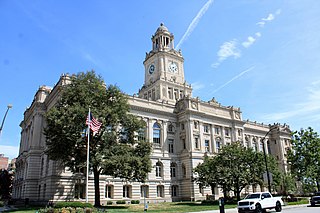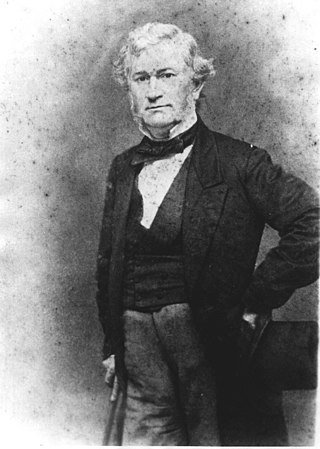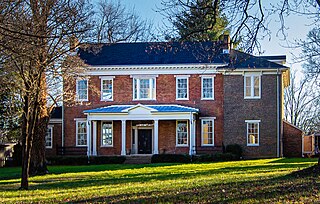
Lieutenant-General Leonidas Polk was a bishop of the Episcopal Diocese of Louisiana and founder of the Protestant Episcopal Church in the Confederate States of America, which separated from the Episcopal Church of the United States of America. He was a planter in Maury County, Tennessee, and a second cousin of President James K. Polk. He resigned his ecclesiastical position to become a major-general in the Confederate States Army, when he was called "Sewanee's Fighting Bishop". His official portrait at the University of the South depicts him as a bishop with his army uniform hanging nearby. He is often erroneously referred to as "Leonidas K. Polk," but he had no middle name and never signed any documents as such.

The Tennessee State Capitol, located in Nashville, Tennessee, is the seat of government for the U.S. state of Tennessee. It serves as the home of both houses of the Tennessee General Assembly–the Tennessee House of Representatives and the Tennessee Senate–and also contains the governor's office. Designed by architect William Strickland (1788–1854) of Philadelphia and Nashville, it was built between 1845 and 1859 and is one of Nashville's most prominent examples of Greek Revival architecture. The building, one of 12 state capitols that does not have a dome, was added to the National Register of Historic Places in 1970 and named a National Historic Landmark in 1971. The tomb of James K. Polk, the 11th president of the United States, is on the capitol grounds.
This is a list of properties and historic districts in Tennessee that are listed on the National Register of Historic Places. There are over 2,000 in total. Of these, 29 are National Historic Landmarks. Each of Tennessee's 95 counties has at least one listing.

The Athenaeum Rectory is a historic building in Columbia, Tennessee that features both Gothic and Moorish architectural elements. Completed in 1837, the building originally served as the rectory for the Columbia Female Institute and as the residence of the school's first president, the Reverend Franklin Gillette Smith. The structure was added to the National Register of Historic Places in 1973.

The Zion Presbyterian Church is a historic building in Maury County, Tennessee. The church was built between 1847 and 1849 of brick in the Greek Revival style. President James K. Polk attended a school conducted by the church. The property was listed on the National Register of Historic Places on June 13, 1972.

OaklandsMansion is an historic house museum located in Murfreesboro, Tennessee, United States. Oaklands is on the National Register of Historic Places and is a local landmark known for its unique Italianate design.

Child of the Sun is a collection of buildings designed by Frank Lloyd Wright on the campus of the Florida Southern College in Lakeland, Florida. The twelve original buildings were constructed between 1941 and 1958. Another of Wright's designs, a Usonian house originally intended for faculty housing, was completed in 2013, and is now part of the Sharp Family Tourism and Education Center. On March 2, 2012, it was designated a National Historic Landmark. The buildings are listed on the National Register of Historic Places, and together form the largest collection of buildings by the architect Frank Lloyd Wright.

The President James K. Polk Home & Museum is the presidential museum for the 11th president of the United States, James K. Polk (1795–1849), and is located at 301 West 7th Street in Columbia, Tennessee. Built in 1816, it is the only surviving private residence of United States President James K. Polk. It was designated a National Historic Landmark in 1961, and is listed on the National Register of Historic Places. As President Polk's primary historic site it is open daily for guided tours.

Rattle and Snap is a plantation estate at 1522 North Main Street in Mount Pleasant, Tennessee. The centerpiece of the estate is a mid-1840s mansion that is one of grandest expressions of the Greek Revival in Tennessee. It was designated a National Historic Landmark in 1971 for its architecture, and for its association with the Polk family, once one of eastern Tennessee's largest landowners. The house is privately owned, but may be viewed by appointment.

St. John's Episcopal Church is a historic Episcopal church in Ashwood, Maury County, Tennessee, United States. Built from 1839 to 1842 by Bishop Leonidas Polk, it was an active church in the Antebellum South. It was ransacked and later used as a hospital for the Confederate States Army during the American Civil War of 1861–1865. Services resumed after the war, but they were discontinued due to low attendance in 1915. It is now closed, except for an annual pilgrimage.

The Seamour and Gerte Shavin House is a Frank Lloyd Wright designed Usonian home in Chattanooga, Tennessee. The house was added to the National Register of Historic Places in 1993.

St. Peter's Episcopal Church is a historic church located at 311 W. 7th Street in Columbia, Tennessee.

The Polk County Courthouse located in Des Moines, Iowa, United States, was built in 1906. It was listed on the National Register of Historic Places in 1979 as a part of the County Courthouses in Iowa Thematic Resource. The courthouse is the third building the county has used for court functions and county administration.

The Polk Sisters' House is a historic house in Columbia, Tennessee, that was the home of two sisters of U.S. President James K. Polk.

Ashwood is an unincorporated community in Maury County, Tennessee, in the United States. Most of the community has been annexed by the city of Mount Pleasant.

Ashwood Hall was a Southern plantation in Maury County, Tennessee.

Lucius Junius Polk (1802–1870) was an American politician and planter from Tennessee.

Skipwith Hall, also known as Skipwith Place, Oakwood Farm, Skipwith Harlan Hill, and Oakwood Hall, is a former plantation and plantation house located in Maury County, Tennessee. It was initially built by Edward Brinley Littlefield and Cornelia Lott Skipwith as their residence.

Not to be confused with Rally Hill, Arkansas

Colonel McNeal House, also referred to as McNeal Place or the Ezekiel Polk McNeal House, is an Italianate mansion in Bolivar, Tennessee, part of Hardeman County, Tennessee. The home was built for Major Ezekiel Polk McNeal's and his wife after their only child, a teenage daughter named Priscilla, died in 1854. Initial construction began circa 1858 and the mansion was completed during the American Civil War circa 1861 - 1862. It was designed by architect Samuel Sloan. In National Register of Historic Places filings it is described as "the finest Italianate house in West Tennessee and among the most outstanding in the state." The residence is a two-story brick building with square cupola. The home is located on Bills Street and Union Street. It is part of the Bills-McNeal Historic District.




















